
Mr. Wellinghoff of the FERC famously said “I think baseload capacity is going to become an anachronism. Baseload capacity really used to only mean in an economic dispatch, which you dispatch first, what would be the cheapest thing to do.” Since then the debate between those that believe baseload is, for the foreseeable future, required and those that believe, like Mr. Wellinghoff that baseload is an anachronism of the 20th century. In fact, recently a paper published by an economist at Duke University claims that North Carolina (apparently serving as a proxy for the entire country) does not require any baseload capacity and that wind and solar can pretty much take care of everything. I have some issues with this latest paper. The author makes some rather sweeping assumptions at the outset regarding a 28% reduction in TOTAL consumption based on his observations of 100 houses and how large the impact of demand response can be from smartgrid initiatives.
As usual, I decided to “do the math” on this issue using government data or, at least, reasonably reputable data for my research. Because I’m no expert on the detailed workings of power generation, and neither are most of my readers, I’m going to make some extremely simplistic assumptions just to try to get at an understanding of the trend and reasonableness of energy generation claims.
First, we need to establish both the history and a mutually understood and accepted forecast of electricity usage in the state of North Carolina. 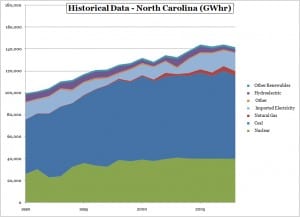 The history is easily obtained using data from the EIA that provides annual energy consumption, including electrical consumption for 1990-2008 for every state in the union. Downloading and graphing this data provides a visual understanding of electrical consumption trends in NC.
The history is easily obtained using data from the EIA that provides annual energy consumption, including electrical consumption for 1990-2008 for every state in the union. Downloading and graphing this data provides a visual understanding of electrical consumption trends in NC.
Forecast data proved a bit more difficult as I could not find North Carolina specific projections for electricity consumption, but the EIA provides consumption forecasts by region, including a detailed forecast of renewable generation.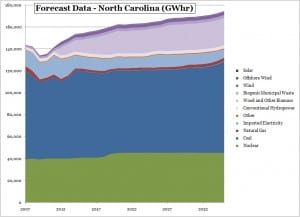 The data provided a two year overlap to the historical data I already had available. So, we could use the trend information from the region to develop data for North Carolina specifically.
The data provided a two year overlap to the historical data I already had available. So, we could use the trend information from the region to develop data for North Carolina specifically.
Since renewable energy has historically played a very small role in electricity generation in North Carolina, all the various forms (excluding hydropower) were lumped together in the historical data. Fortunately, the EIA split these apart in some detail in the forecasted data. This allows us to examine each renewable option in more detail and adjust the numbers accordingly.
All renewables are represented in shades of purple on the forecasted graph in order to allow a clearer visual of the impact as we consider various scenarios. Some immediate information from the graph as laid out here to consider. First, a significant increase in the use of wood and other biomass in the generation of electricity is clear. This represents almost all of the gains in renewable energy with some modest gains for wind identified as well. Interestingly, virtually all new generation is presumed to be renewable based with only a small increase in nuclear and a modest increase in coal over this 28 year projection.
However, as has been stated by many, it is imperative to reduce our carbon dioxide emissions significantly or risk catastrophe on a planetary scale. This forecast is doing nothing to reduce emissions in North Carolina. Many have also stated that nuclear is not necessary and should also be eliminated. So let us explore those options here.
Claims have been made that distributing intermittent renewable sources like wind and solar will eliminate the intermittency issue and allow these sources to act as a relatively constant source of power. Thus not requiring significant energy storage capability. A second assumption is that transmission and distribution issues will not limit development of any renewable energy option. Both of these premises are key for the practical implementation of intermittent resources like solar and wind power. For the sake of argument, we will accept that premise as true and look at the relative scale of required facilities to generate sufficient power to fully replace all other generation, including imported electricity, natural gas (a limited resource), coal and nuclear.
One further set of assumptions, given the nature of hydropower and the already agressive plans in place for biomass, we will presume both of these sources will remain unchanged from the EIA forecast. This leaves just wind (on shore and off-shore) and solar to consider further.
Wind Assessment
According to NREL, North Carolina has about 2500 MW of developable land based wind installed capacity. As you can see from the map above this is located in the western portion of the state. We will assume that all of this is developed and generates at about 30% capacity. Given that wind operates at about 20% of capacity currently, this is a generous allowance for improved technology. That would mean potential on shore wind generation of about 6500 GWh.
2500 MW of wind would require 1000 2.5 MW wind turbines. Given the mountainous terrain, assuming 100 would be installed per year seems reasonable. The projected life of these turbines is about 20 years. New turbines would be required to replace older installations after that time. Each 2.5 MW turbine would generate about 6.5 GWh after installation. With maximized contribution from wind in the state, we’ve cut the amount of imported power in half.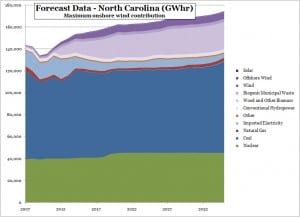
Off shore wind has been frequently discussed as a large untapped potential source for energy for North Carolina, but one can see that the contribution forecasts from the EIA data shows a very modest contribution to our energy needs even as far out as 2035.
Using data from a pro-wind group, 18,300 MW of off shore wind potential was identified. Assuming similar capacity factors, this has the potential to generate 48,000 GWh per year. The Cape Wind project in Massachusetts is planning to use wind turbines of 3.6 MW, assuming a comparable turbine size for any projects off the North Carolina coast means that about 5000 turbines would be required. Each turbine would generate 9.6 GWh per year after installation. Given the difficulty of installation, I’ve assumed 100 turbines can be installed in 2014, ramping up to 500 per year by 2020.
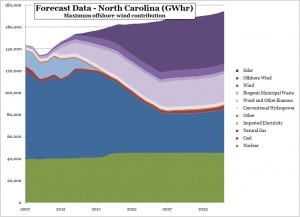 With this additional wind energy, the use of coal has been reduced by about half and no power is required to be imported to the state. Nuclear continues to contribute at full capacity as does natural gas.
With this additional wind energy, the use of coal has been reduced by about half and no power is required to be imported to the state. Nuclear continues to contribute at full capacity as does natural gas.
The remaining renewable to consider here is solar power. In general North Carolina is not considered to be a great resource for solar power, but the sun does shine here, so in theory, one could install additional solar capacity. Again, in the EIA forecast, the added contribution of solar to the state’s electricity generation is very modest and, in fact, is a barely visible slice on the graphs.
Thermal solar power consists of using mirrors to concentrate sunlight on a liquid, heating the liquid up and spinning a turbine much like coal or nuclear power. This form of solar generation requires very consistent direct sunlight. As such, this is not practical for the North Carolina climate. The state is in a temperate climate with significant cloud cover throughout the year. For this reason, we will consider photovoltaic (PV) panel installations as the most likely candidate for use in the state.
There are dozens of claims regarding solar panel efficiency and power generation, but the most common value I noted was about 150 watts per square meter. Of course, that is the maximum output under optimal conditions. At best a solar panel operates at this peak output for six hours per day, assuming no intervening shade or clouds reduces the output. This means that one solar panel generates, at best, 0.9 kWh/day. Given North Carolina has both cloud cover and seasonal variation, an average daily output of 0.5 kWh/day per panel seems a reasonable approximation. One PV panel can generate 182.5 kWh/year.
First, let’s consider how many panels could be installed in residential applications. In 2008, the state claims there were almost 2.5 million homeowners. Assuming that renters cannot install panels on their home and that we could average 2 panels per house, that means that 5 million panels can be installed. This would generate 900 Gwh per year.
Commercial and industrial buildings could be well suited to solar PV on the roof top, but data is difficult to obtain. State statistics indicate 643,000 firms within the state. If we assume that each of them can install 10 solar PV panels on average, then an additional 6.43 million panels can be installed. This would generate 1200 GWh per year.
In addition, there are 52,500 farms in the state. If each farm installed 25 PV panels on the various buildings and roofed structures, then an additional 1.3 million panels, generating 240 GWh per year would be installed.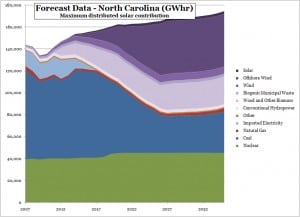
Total distributed solar capacity would be 2340 GWh/year with the installation of almost 13 million solar panels. Making the assumption that a million solar panels can be installed each year starting in 2011, results in a modest impact of solar renewable energy on the total energy mix.
In order for solar power to have more than a modest impact on electricity generation in North Carolina, industrial solar installations will have to be considered.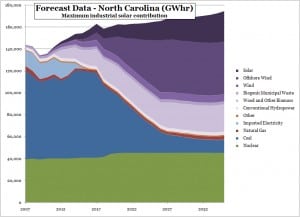 From industry literature, a 2MW installation in Colorado covers about 12 acres of land. Remembering the basic efficiency factors, a 2MW installation would generate 2.2 GWh per year. Assuming larger installations are scalable, a 100 MW installation, covering 600 acres of land could generate 110 GWh/year. Assuming that in addition to the large wind and distributed solar installations, 10 such installations could be completed every year starting in 2011, the total impact of solar is still insufficient to even completely displace coal.
From industry literature, a 2MW installation in Colorado covers about 12 acres of land. Remembering the basic efficiency factors, a 2MW installation would generate 2.2 GWh per year. Assuming larger installations are scalable, a 100 MW installation, covering 600 acres of land could generate 110 GWh/year. Assuming that in addition to the large wind and distributed solar installations, 10 such installations could be completed every year starting in 2011, the total impact of solar is still insufficient to even completely displace coal.
Conclusions
By looking only at the fundamental energy balance, ignoring the furor over baseload and energy storage, it is clear that renewable energy systems available today simply cannot fully replace forecasted energy requirements. Even after forecasting the construction of an additional 1000 land based wind turbines, 5000 off shore wind turbines, 13 million solar panels and 300 solar farms, insufficient energy is generated to eliminate all coal fired power plants.
If we truly want to eliminate carbon dioxide in our electrical generation, we must consider nuclear as a key option to include in this mix. However, nuclear alone will not get us to a carbon free electrical generation by the year 2035. 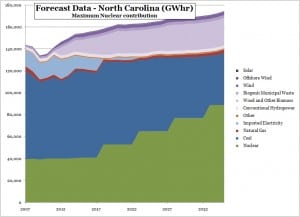 Each 1500 MW nuclear plant built generates almost 12000 GWh per year. Looking at the original forecast graph and assuming one new nuclear plant every five years within the state’s borders, at the end of the 2035, we would still require significant quantities of coal to generate electricity. We need to consider ALL of our options and build ALL of them as quickly as we can.
Each 1500 MW nuclear plant built generates almost 12000 GWh per year. Looking at the original forecast graph and assuming one new nuclear plant every five years within the state’s borders, at the end of the 2035, we would still require significant quantities of coal to generate electricity. We need to consider ALL of our options and build ALL of them as quickly as we can.


“we must consider nuclear as a key option to include in this mix. However, nuclear alone will not get us to a carbon free electrical generation by the year 2035.”
But nuclear can get to a carbon free electrical generation by some future time. No other combination of power sources can. So why divert good planning and scarce resources onto renewables when a nuclear build, “all speed ahead” order should be given.
A fair question. My only response is that I’m concerned that it simply takes too long to build nuclear to go with it alone. Perhaps if the planned efficiencies in licensing processes demonstrate a significant improvement, we can adjust this forecast.
I’m also using NC as an analog for the entire US. Consider whether it is feasible to build 50 new plants every five years for the next 20 years. This would be double the 100 plants Senator Alexander proposes. I suggest a diversity of options might be more feasible.
Margaret – your installation rate and capacity factors for wind and solar are perhaps a bit generous, but that is a quibble. Why do you think that the installation rate for new nuclear power would be limited to just one plant every five years? Sure, it takes a while to get a single plant constructed, but why can’t companies like Duke and Progress build several at a time or at least overlap the starting dates so that the overall rate turns out to be closer to one every year or two?
We have been there before – even with significant and organized opposition. We can get there again, especially if we keep working to reduce the power of the opposition by finding as many friends and allies as possible.
Rod,
Yes, I was intentionally generous with the capacity factors and installation rates for renewable projects. I wanted to demonstrate that with even the most generous and aggressive considerations, these technologies will simply not get the country where it needs to be in terms of carbon emissions.
Conversely, for the nuclear build, I was looking at what I considered to be a sustainable build rate considering that the entire country, state-by-state must look at similar choices. If one considers North Carolina as an analog for the entire country, then one plant every five years becomes 50 plants every five years. I think this is a very aggressive goal as a country. Achievable, but aggressive. If I were considering North Carolina in complete isolation, then I would probably have at least doubled the rate.
Margaret
So lets stick with coal and add what we can…what is the big deal. Done!
geo,
Sticking with coal means dumping more carbon dioxide into the atmosphere. I, for one, believe that human activity is at least contributing to excess amounts of CO2 and we need to find ways to reduce our contributions. While it is far more important to help developing countries like China and India to bring electricity to their populations with as few emissions as possible, I think it is important for the US to “walk the talk”.
If you don’t believe in the impacts of CO2, then look at the damage coal mining is doing to the environment and decide whether you really want to support the chopping off of mountain tops and filling of the valleys with the waste materials. Consider also the fly ash that is the solid waste from coal burning power plants and its huge environmental impact.
Margaret
Margaret,
Nice article. Many good points and generous as others have noted. I still contend that a long range energy plan is needed. Perhaps just as you would have critical path schedule for a major project, with backup coverage, we need something even better for our energy plan.
I like the expression, “walk the talk”.
Margaret,
Good work, and I won’t quibble about the assumption that every one of the 643,000 firms in NC has its own rooftop on which to install PV panels (a lot of them are probably in office buildings, i.e., one rooftop, owned by a commercial lessor who will install the panels only if and when someone makes it worth his while).
I have heard others advocate “build it all” and my only concern relates to cases where it’s public money that builds “it.” My concern is that an ill- or mis-informed public will support the politically correct option — renewables like wind and solar — at the expense of the real solution, which is nuclear.
The wind/solar option of course means natural gas. Gas build will accompany wind/solar build, ensuring that baseload needs will be met, even though the public mistakenly thinks the needs are met by renewables. Even if the public does eventually clue in, it will be too late: there will be enough gas to cover baseload needs for the foreseeable future. Meanwhile GHGs will pour into the air to the tune of millions of tons per year.
This is exactly — and I mean EXACTLY — what is happening in Ontario. The government and gas lobby talk only about wind, but on the ground it’s gas baby gas. And the Darlington new nuclear build, 3,500 MW of nuclear capacity, is now submerged, perhaps permanently.
I think it’s best to persuade everyone now that nuclear is the way to go, rather than waiting for a future in which the renewables fantasy has proved itself to be just the gas industry PR stunt that fooled everyone in 2010.
Steve,
That was why I assumed only 10 PV per firm. Some (many) would have none, but others could have many more than 10.
I understand all of the arguments made why solar and wind are not a good idea, and the general game being played by gas companies. The intent of my blog was to make it clear that these options alone would not achieve the stated goal of “carbon-free” generation. Especially in Canada where solar power must, by it’s very nature be a limited resource. What I’ve found is that people aren’t thinking through the math about the real viability of wind and solar. By “doing the math” I hope I’m making those ludicrous claims clear and let intelligent people think it through for themselves.
A lofty goal perhaps, but I can hope.
Margaret, I totally agree (I only look contumacious!). Of course it’s essential to walk through the numbers. But we have to keep in mind that the wind/solar advocates are probably not innumerate — they’re just pretending to be.
This tracks back to the Social Media thread that began with the announcement of the web conversation with Stewart Brand back in early February. Anti-nukes are perfectly aware that their numbers don’t add up, and they’re perfectly fine with advocating “solutions” whose success depends on an unprecedented expansion of gas-fired power generation.
(The same “environmentalists” scream about the Alberta oil sands and conveniently ignore the fact that oil sands GHGs are from natural gas — the very same substance they want power systems to run on.)
This is a political issue, which calls for a political communication strategy. Politics is about who gets what. When groups like Sierra get into bed with the gas lobby, there’s nothing wrong with pointing at the money trail and using rhetorical devices to rile up onlookers.
Sound numbers are essential, and so is the gut-level stuff.
Steve,
I would never accuse you of being contumacious – mostly because I can’t spell it! Yep, I know that the anti-nukes/environmentalists don’t want to hear the numbers. I also know that we need to be doing a better job of selling nuclear in the political, but I need to have numbers I can believe in my head in order to sell something. I also know that there are many, many people who need to hear the logical and sound arguments to have some faith.
geo says:
March 25, 2010 at 1:29 pm
“So lets stick with coal”
You might want to look into the price trends for ‘delivered coal’.
On the US Eastern Seaboard the price is running $80-$100/ton. A 1,000 megawatt coal plant needs 3+ million tons per year.
Of course the price delivered price in Wyoming is only $20/ton.
http://www.eia.doe.gov/cneaf/coal/page/acr/table34.html
Assumptions of “zero” carbon emissions are irrational when viewed in the context of CO2 generated from natural sources.
Further, assertions that “… it is imperative to reduce our carbon dioxide emissions significantly or risk catastrophe on a planetary scale.” are pure speculation and utterly unable to be proved.
The real problem is limited supplies of reasonably priced energy; the lifeblood of all economies. Concentrate on the more efficient production and use of energy and the greenhouse gas problem (whether real or imagined) is solved as a by-product.
My concern with carbon-based energy sources is somewhat independent of the global warming argument. I look at what coal mining is doing to our mountains and the issues of fly ash, ash ponds, and the impacts of this permanently toxic waste have on the communities near them.
Oil and our dependence on unstable regions of the world or drilling scenarios like the Deep Water Horizon well.
So, I support the idea of moving away from these sources, regardless of global warming. I have held this stance since the 1970’s during the first oil crisis – which is why I became a nuclear engineer. None of the other energy sources made sense in the long term.
That said, I believe that experts in climate see a trend in global warming that indicates a man-made effect. Unless we reduce the added burden on the atmosphere, we could have some serious issues. As I live in a coast community, perhaps I’d rather be safe that sorry.
A useful analysis indeed, as long as you are clear how generous you are being toward wind and solar all around.
You can do as you like, Margaret, but perhaps it should not be axiomatic that carbon is a pollutant or the bringer of doom.
Let those who care not about reality spend kilo-hours of planning and analysis time worrying about a carbon-free future.
Those concerned about the real world can then pay attention to what matters: providing enough energy to move into a far more sophisticated future, where people understand that “the map is not the territory.”
My concern with carbon-based energy sources is somewhat independent of the global warming argument. I look at what coal mining is doing to our mountains and the issues of fly ash, ash ponds, and the impacts of this permanently toxic waste have on the communities near them.
Oil and our dependence on unstable regions of the world or drilling scenarios like the Deep Water Horizon well.
So, I support the idea of moving away from these sources, regardless of global warming. I have held this stance since the 1970’s during the first oil crisis – which is why I became a nuclear engineer. None of the other energy sources made sense in the long term.